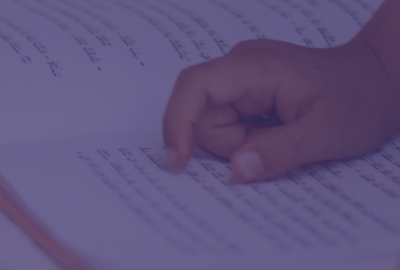
by Maggie Moroff
Advocates for Children of New York
Context
Teaching all children how to read and write is one of the most fundamental responsibilities of our public schools. Basic literacy skills are essential for success in school, employment in the twenty-first century economy, and full participation in civic life.1 Yet far too many schools are struggling to fulfill this core mission, as evidenced by the fact that 32 percent of the nation’s fourth graders and 24 percent of eighth graders scored below basic in reading on the National Assessment of Educational Progress (NAEP) in 2017.2 The consequences are grave: children who do not become proficient readers in elementary school are less likely to graduate from high school and are at increased risk for behavioral and mental health challenges, while adults with low literacy levels are less likely to be employed full time, are more likely to have incomes that put them below the poverty line, and are over-represented amongst the incarcerated.3
Evidence
As laid out by the National Reading Panel nearly two decades ago and further confirmed by subsequent research, while our brains are wired from birth for spoken language, learning to read is not a natural or automatic process.4 Because written language is a relatively recent invention within human history, there are no neurological structures specifically devoted to reading and understanding print; instead, the brain has to build new connections between areas that evolved for other purposes, like speech and vision. While some children will learn to read regardless of the instructional methods used, there is a strong scientific consensus that the vast majority of students need to be directly taught how to break the code that links the sounds of spoken language to the letters that represent those sounds on the page.5
While not all struggling readers have disabilities, and not all students with disabilities need extra support in the area of literacy, referral to special education is frequently prompted by poor performance in reading. In the 2017-18 school year, 7 million children, comprising 14 percent of all students enrolled in U.S. public schools, received special education supports and services under the Individuals with Disabilities Education Act (IDEA); over half of these students were classified as learning disabled (34 percent) or speech/language impaired (19 percent).6 Such students are typically those hardest hit by the lack of district-level commitment to providing high-quality, evidence-based literacy instruction to all children. On the federal reading assessment called the National Assessment of Educational Progress (NAEP), for example, 81 percent of students without Individualized Education Programs (IEPs) in grade 8 scored at or above basic in 2017, compared to only 35 percent of eighth graders with IEPs.7 This tremendous gap is not inevitable or a consequence of disability itself. Research is clear that students with language-based learning disabilities, such as dyslexia, are fully capable of learning how to read, provided they are taught effectively. 8 Moreover, what is essential for children with dyslexia—explicit, systematic instruction in the foundational skills that underlie proficient reading—is beneficial for all students, regardless of the existence of disability.9
The problem instead can be attributed to a systemic failure to equip all educators with the knowledge, training, and resources they need to teach reading effectively and to provide all struggling students with prompt intervention and sufficient supports to address their literacy needs.10 Teaching children—especially those with disabilities like dyslexia—how to read requires significant expertise and training in evidence-based, age-appropriate methodologies.11 Presently, however, many teacher preparation programs provide pre-service educators with scant information on teaching children with disabilities and are not grounded in the extensive research base on how children learn to read, while districts often use a hodgepodge of instructional methods and fail to provide their teachers with the ongoing support they need to improve their practice.12 Furthermore, too often, school districts lack the systems and resources needed to screen students for reading disabilities and provide those who need more targeted, individualized support with the help they need before they start to fall behind.
Recommendations
- Policymakers should ensure that every school district has a comprehensive, multi-year action plan for meeting the literacy needs of all students. The plan should include assessing the school system’s capacity to provide evidence-based literacy instruction and intensive interventions to students, including those with a range of disabilities, at all grade levels; consulting with experts regarding best practices; engaging with parents and other stakeholders; and articulating specific goals, with a timeline and budget, for ensuring all students learn to read.
- Policymakers should ensure that teacher education programs prepare all teachers—not just those specializing in literacy interventions—to effectively serve students with reading disabilities. Teacher preparation programs must provide all future educators with at least a base-level understanding of the science of reading as well as training in evidence-based teaching methodologies that provide explicit, systematic instruction in foundational literacy skills and are proven to help struggling readers progress, whether or not they have disabilities such as dyslexia.
- Policymakers should ensure that all school districts offer professional development and ongoing support to educators working with students across ages and abilities who are learning to read. School districts should assess current capacity to teach literacy skills and develop comprehensive plans for meeting the literacy needs of all their students.
- Policymakers should ensure that every school district has the resources needed to hire dedicated, highly trained expert teachers of reading who can provide direct, individualized, and evidence-based interventions to struggling students, as well as coaching and support to classroom teachers.
- School districts must partner with families to promote literacy and ensure families concerned about their children’s reading progress know how to get help.
Bottom Line
A great number of students, with and without disabilities, struggle to learn how to read. It is critical that schools and districts are prepared to offer explicit, systematic instruction in foundational literacy skills to all students. At the same time, schools must be prepared to offer targeted interventions and more intensive support to those students, regardless of grade level, who have common language- based learning disabilities like dyslexia. Another generation of students should not be left to struggle with reading when we know what instructional methods will help them be successful.
Policymakers should focus attention and resources on ensuring that every child in their jurisdiction learns to read.
Examples of Best Policy/Practice
- Advocates for Children of New York
- American Public Media, Hard to Read (2017), Hard Words (2018), and At a Loss for Words (2019):
- International Dyslexia Association
- National Center on Intensive Intervention
- The Reading League
- Reading Rockets
- What Works Clearinghouse, Foundational Skills to Support Reading for Understanding in Kindergarten Through 3rd Grade (2016)
- Yale Center for Dyslexia & Creativity
Author
Maggie Moroff, Special Education Coordinator Advocates for Children of New York
Footnotes
-
Reardon, S.F., Valentino, R.A., & Shores, K.A. (2012). Patterns of literacy among U.S. students. Future of Children, 22(2),17–37. https://doi.org/10.1353/foc.2012.0015
-
McFarland, J., Hussar, B., Zhang, J., Wang, X., Wang, K., Hein, S., … Barmer, A. (2019). The Condition of Education 2019 (NCES 2019–144). U.S. Department of Education. Washington, DC: National Center for Education Statistics. Retrieved from: https://nces.ed.gov/pubs2019/2019144.pdf
-
Greenberg, E., Dunleavy, E., & Kutner, M. (2007). Literacy Behind Bars: Results From the 2003 National Assessment of Adult Literacy Prison Survey (NCES 2007-473). U.S. Department of Education. Washington, DC: National Center for Education Statistics.
Retrieved from: https://nces.ed.gov/pubs2007/2007473.pdfHernandez, D.J. (2012). Double Jeopardy: How third grade reading skills and poverty influence high school graduation.Baltimore, MD: The Annie E. Casey Foundation. Retrieved from: www.aecf. org/resources/doublejeopardy/
Kutner, M., Greenberg, E., Jin, Y., Boyle, B., Hsu, Y., & Dunleavy, E. (2007). Literacy in Everyday Life: Results From the 2003 National Assessment of Adult Literacy (NCES 2007–480). U.S. Department of Education. Washington, DC: National Center for Education Statistics. Retrieved from: https:// nces.ed.gov/Pubs2007/2007480.pdf
Miles, S.B., & Stipek, D. (2006). Contemporaneous and longitudinal associations between social behavior and literacy achievement in a sample of low-income elementary school children. Child Development, 77(1), 103–117. https://doi.org/10.1111/j.1467-8624.2006.00859.x
-
National Reading Panel. (2000). Report of the National Reading Panel. Teaching children to read: An evidence-based assessment of the scientific research literature on reading and its implications for reading instruction (NIH Publication No. 00-4769). Washington, DC: National Institute of Child Health and Human Development (NICHD). Retrieved from: https://www.nichd.nih.gov/about/org/der/branches/cdbb/nationalreadingpanelpubs
-
Castles, A., Rastle, K., & Nation, K. (2018). Ending the reading wars: Reading acquisition from novice to expert. Psychological Science in the Public Interest, 19(1), 5–51. https://doi org/10.1177%2F1529100618772271
-
McFarland et al. (2019).
-
U.S. Department of Education, Institute of Education Sciences, National Center for Education Statistics. National Assessment of Educational Progress (NAEP), 2017 Reading Assessment. Retrieved from: https://www.nationsreportcard.gov/ndecore/
-
Duff, F.J., & Clarke, P.J. (2011). Practitioner Review: Reading disorders: What are the effective interventions and how should they be implemented and evaluated? The Journal of Child Psychology and Psychiatry, 52(1), 3–12. https://doi.org/10.1111/j.1469-7610.2010.02310.x
Shaywitz, S.E., Morris, R., & Shaywitz, B.A. (2008). The education of dyslexic children from childhood to young adulthood. Annual Review of Psychology, 59, 451–475. https://doi.org/10.1146/annurev.psych.59.103006.093633
-
Castles, Rastle, & Nation (2018); National Reading Panel (2000).
-
Catone, W.V. & Brady, S.A. (2005). The inadequacy of Individualized Education Program (IEP) goals for high school students with word-level reading difficulties. Annals of Dyslexia, 55(1), 53-78. https://doi.org/10.1007/s11881-005-0004-9
Lyon, G.R., Shaywitz, S.E., Shaywitz, B.A., & Chhabra, V. (2005). Evidence-based reading policy in the United States: How scientific research informs instructional practices. Brookings Papers on Education Policy. Retrieved from: http://languagelog.ldc.upenn.edu/myl/ldc/llog/EvidenceBasedReadingPolicy.pdf
-
Moats, L.C. (1999). Teaching reading IS rocket science: What expert teachers of reading should know and be able to do. Washington, DC: American Federation of Teachers. Retrieved from: http://www.aft.org/sites/default/files/reading_rocketscience_2004.pdf
-
Joshi, R.M., Binks, E., Graham, L. Ocker-Dean, E., Smith, D.L., Boulware-Gooden, R. (2009).
Do textbooks used in university reading education courses conform to the instructional recommendations of the National Reading Panel? Journal of Learning Disabilities, 42(5), 458-463. https://doi.org/10.1177%2F0022219409338739
Ness, M.K., & Southall, G. (2010). Preservice teachers’ knowledge of and beliefs about dyslexia. Journal of Reading Education, 36(1), 36-43.

